Pascale Petit's Blog, page 6
January 16, 2013
Hand-feeding Birds in Paris
Hand-feeding the birds in Paris is compulsive. I do it every time I go. My favourite are the sparrows. On one visit I would wander down to Notre Dame square every evening with a madeleine longue, rice or birdseed bought in the nearby bird market. I love the sensation of their tiny gripping claws, and I talk to them of course. There are regulars who feed them every day, every year, that the birds know, who attract a flock as soon as they arrive with their carrier bags full of seed or bread. If I don't have any food on me I'll ask them for a hand-full of theirs, and chat to them about the ways of sparrows, or gulls, crows, pigeons, starlings - they all take their turns. When I was four I lived in a children's home south of Paris called the Mésangerie – the tit-house – and the birds of Paris I encounter now remind me of those infants in their nest-like dormitories, and also of Annette Messager's sculptures The Boarders and Knit for Sparrows, with her sparrow corpses obsessively dressed in knitted capes and crocheted bonnets, laid out to sleep in boarding rooms. The sparrows – or moineaux – seem miraculous to me, as I live in east London, where they have virtually vanished, though they were plentiful when I first moved here twenty-five years ago. A special treat is to see them having a dust-bath just by the privet in front of Notre Dame, which I remember they used to do on the pavement outside my house once, so often I didn't always marvel at their ritual.
 Me hand-feeding the sparrows on the parvis of Notre Dame, over the box privet, I took the photo on my iPhone with my other hand.
Me hand-feeding the sparrows on the parvis of Notre Dame, over the box privet, I took the photo on my iPhone with my other hand.
 The gull man this Christmas on the Pont au Double. He has trained them to eat from his lips as well, I love the queue!
The gull man this Christmas on the Pont au Double. He has trained them to eat from his lips as well, I love the queue!
 The crows of the Jardin des Plantes, at twilight, closing time, this Christmas. A woman arrived with a bag of bread and hundreds crowded around her.
The crows of the Jardin des Plantes, at twilight, closing time, this Christmas. A woman arrived with a bag of bread and hundreds crowded around her.
 This man must be a regular. He was so engrossed in his sparrows it was captivating. I did ask for a hand-full of breadcrumbs from him and they devoured them instantly.
This man must be a regular. He was so engrossed in his sparrows it was captivating. I did ask for a hand-full of breadcrumbs from him and they devoured them instantly.
 The pigeon man of Notre Dame
The pigeon man of Notre Dame
 The pigeon woman of Notre Dame offering rice, Christmas 2011
The pigeon woman of Notre Dame offering rice, Christmas 2011
 Me hand-feeding the sparrows on the parvis of Notre Dame, over the box privet, I took the photo on my iPhone with my other hand.
Me hand-feeding the sparrows on the parvis of Notre Dame, over the box privet, I took the photo on my iPhone with my other hand.
 The gull man this Christmas on the Pont au Double. He has trained them to eat from his lips as well, I love the queue!
The gull man this Christmas on the Pont au Double. He has trained them to eat from his lips as well, I love the queue! The crows of the Jardin des Plantes, at twilight, closing time, this Christmas. A woman arrived with a bag of bread and hundreds crowded around her.
The crows of the Jardin des Plantes, at twilight, closing time, this Christmas. A woman arrived with a bag of bread and hundreds crowded around her. This man must be a regular. He was so engrossed in his sparrows it was captivating. I did ask for a hand-full of breadcrumbs from him and they devoured them instantly.
This man must be a regular. He was so engrossed in his sparrows it was captivating. I did ask for a hand-full of breadcrumbs from him and they devoured them instantly. The pigeon man of Notre Dame
The pigeon man of Notre Dame The pigeon woman of Notre Dame offering rice, Christmas 2011
The pigeon woman of Notre Dame offering rice, Christmas 2011
Published on January 16, 2013 10:03
November 20, 2012
Metamorphosis: Poetry from Art at Tate Modern, autumn 2012, war poetry and Brian Turner

Last night was our last session of the poetry from art autumn term at Tate Modern so we spent the second part of the class in a reading celebration. For the first part we responded to two monumental war paintings: Leon Golub's Vietnam II and the Iraqui artist Dia al-Azzawi's Sabra and Shatila Massacre, which depicts the massacre of Palestinian refugees in Beirut in 1982. We discussed the difficulty of writing poems about war when not a combatant, but these two artists were not directly involved with the wars they depict. Is it possible to write authentically about such a huge subject if we have not experienced it? I've worked with students in Algiers who have lived through and are still living through terrorism, and mentored the UK poet Mir Mahfuz Ali, who writes powerful poems about the trauma of war in Bangladesh, and one of the problems for them is being too close to the subject, as well as the events simply being too shocking for the reader to be able to take in. So we studied three poems by Brian Turner, from his collections Here, Bullet and Phantom Noise , about his time as a soldier in the Iraq war, to see how he dealt with being up close, and how he found a language for unspeakable things.
 Vietnam II by Leon Golub (detail)We used three of Turner's poems as models for possible approaches to such a tricky subject. His poem 'Here, Bullet', for example, focuses on one detail of war: a bullet. The speaker talks to the bullet, which is whizzing through the air, so speed is arrested for the space of the poem, to allow a human to engage with a power object, and offer himself as a sacrifice to it against the harm it continues to do. Addressing the bullet rather than the 'enemy' takes away notions of blame and gives the soldier-poet distance, so although the tone is passionate this device gives him the objectivity to make a work of art. I suggested the group try picking out a detail from Golub or Azzawi's paintings instead of taking on the whole composition.
Vietnam II by Leon Golub (detail)We used three of Turner's poems as models for possible approaches to such a tricky subject. His poem 'Here, Bullet', for example, focuses on one detail of war: a bullet. The speaker talks to the bullet, which is whizzing through the air, so speed is arrested for the space of the poem, to allow a human to engage with a power object, and offer himself as a sacrifice to it against the harm it continues to do. Addressing the bullet rather than the 'enemy' takes away notions of blame and gives the soldier-poet distance, so although the tone is passionate this device gives him the objectivity to make a work of art. I suggested the group try picking out a detail from Golub or Azzawi's paintings instead of taking on the whole composition.'Easel' uses the metaphor of a soldier painting a canvas of blue and desert yellows as he bombs his target, so that the action is conveyed through date palms that "open / in a burst of green" and where people are "mere phantasms / of paint, their features unrecoverable, their legs / disappearing...". Again, everything in the poem is happening at high speed, and the conceit of painting distances what might otherwise be too unbearable to describe. We read how Leon Golub, when he was painting Vietnam II and after the first layer of paint was applied, placed his vast canvas on the floor and scraped it down with a meat cleaver before reconstructuring the figures of American soldiers and Vietnamese civilians. The painting process could be a way in to write a poem, allowing the scene to remain open and metaphoric.
'Howl Wind', from Phantom Noise freezes a crucial moment, when a missile is released from "the high angle of hell" and the poem switches from this sky-high angle to zoom in on particular lives, couples who must kiss or say what's on their minds now, before "the steel-hard visitations of death" – "now is the time". Perhaps, like 'Howl Wind', a poem can imagine the sounds of a massacre (which can only be suggested in the painting), or shift angle to high up or ground level, play with perspective and scale. Anything that allows the imagination to fully inhabit the horror within a contained frame, to make order – art – out of chaos.
 Sabra and Shatila Massacre by Dia al-Azzawi
Sabra and Shatila Massacre by Dia al-Azzawi
Published on November 20, 2012 05:01
November 17, 2012
BBC Radio 4 Expressing Pain and Frida Kahlo

A few weeks ago I was interviewed by Dr Stuart Flanagan for a BBC Radio 4 documentary 'Expressing Pain'. He asked me about my book What the Water Gave Me: Poems after Frida Kahlo and was interested in how I'd written poem versions of Kahlo's paintings, expressing how her "art works on the pain spectrum". Like many people I've often struggled at the doctor's to describe what pain feels like, especially when the doctor seems rushed and sometimes uninterested, so it was a revelation to be in the company of one who was so concerned to know what patients' pain feels like that he was making a documentary about it. When I say he was interested it would be more accurate to say he was passionate about his subject. The documentary, produced by Rebecca Maxted, is broadcast on Monday 19th November at 4pm and lasts about half an hour. You can listen to it here: http://www.bbc.co.uk/programmes/b01nxh2l
As well as focusing on how artists have depicted pain in their work the programme will include an interview with chronic pain sufferer and artist Deborah Padfield, who works with chronic pain patients to create visual representations of their pain. It will also chart the progress of one of these patients as he visits his doctor and makes paintings about his suffering.
There would be a revolution in health care if doctors did take the role of art in managing – and transforming – pain more seriously. Certainly, in the case of Frida Kahlo it was a lifeline. Her life could have been unremittingly ugly, had she not found ways to transform her suffering into paintings while she was in hospital, recovering from that horrific bus crash in her teens. It left her with chronic and often acute pain for the rest of her life. The resulting paintings might express that pain unflinchingly, but they are also stoic, astonishingly alive, and defiant. They celebrate life in all its gore and glory.
Here is my fifth poem about her painting What the Water Gave Me, where she is lying in her bath surrounded by scenes from her paintings and episodes from her life that float around her legs like hallucinatory islands. The bath water is a scrying glass, but it's also a place of healing, a retreat to soothe away pain. In my poem I'm imagining her process of painting and how the act of making art, with the altered state it can put the artist into, can help:
What the Water Gave Me (V)
The water enters my pores gently.
When it sings all my body listens,
the little hairs dawdle
in calm eddies.
It is like painting then, that lost hour
when the colours play together
before becoming a mouth,
the rough face
not yet human.
One eye drowning in its rockpool
finds a tunnel of rippled light
and opens
to gaze at its maker.
And I,
all alone with my painted bath,
my one-thread brush
grafting skin,
my sea-changed skeleton
a surprise reef
where fingers of live coral
knit the shattered spine.
My out-of-the-frame head
not throbbing now.
The water a poured mirror, its song
rising up the chromatic scale
to create land on the surface.
The currents shiver like shaken glass
splashing my legs with shoals of pigment –
the blue sting, the red ache,
how art works on the pain spectrum.
© Pascale Petit What the Water Gave Me (Seren, 2010, Black Lawrence Press 2011)
Published on November 17, 2012 03:09
September 25, 2012
Breaking Boundaries Poetry Course, Ty Newydd August 2012

What a magical place Ty Newydd is, I've taught there countless times. 'Breaking Boundaries' was my second poetry course co-tutored with the very funny Daljit Nagra. Our guest reader was Karen McCarthy Woolf, who gave us an electric reading on Tuesday and who swam in the sea morning and night. On the last evening a boy passed through with his pet, Barnie the barn owl, and with his father who held a goshawk, just as I was going back to my room to collect notes. I thought how Welsh this was, how wizardish. I'd never stroked an owl before, a juvenile who felt like melting snow. We did work very hard that week. We taught hard and the group wrote many new poems, some breaking their own boundaries, A few are already getting them accepted for magazines, but it was a glorious haven and the sea sparkled on the horizon. Every now and again I'd walk down the lawn to the stile and just look at it, breathing it all in.
 Goshawk
Goshawk It's hard working in the sun: Phoebe, Rachel and Roy working on their poems
It's hard working in the sun: Phoebe, Rachel and Roy working on their poems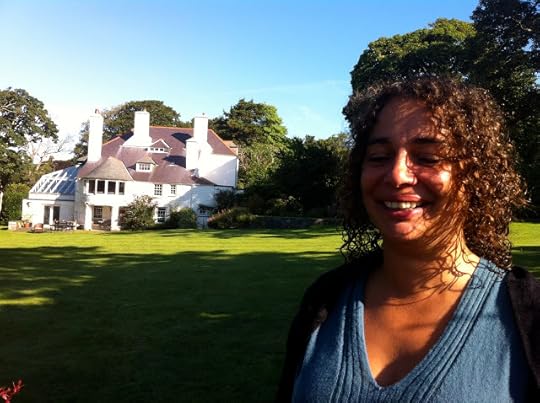 Karen McCarthy Woolf our superb guest reader, on the lawn
Karen McCarthy Woolf our superb guest reader, on the lawn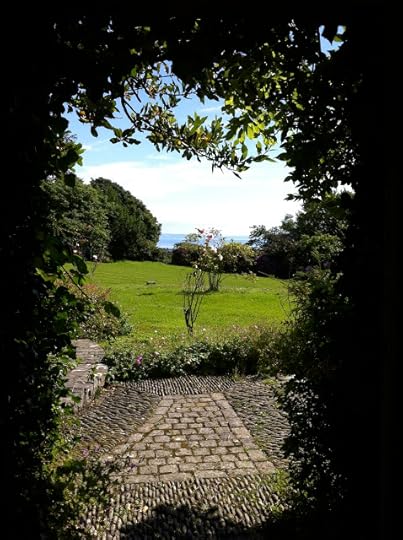 Ty Newydd gardens with view of sea
Ty Newydd gardens with view of sea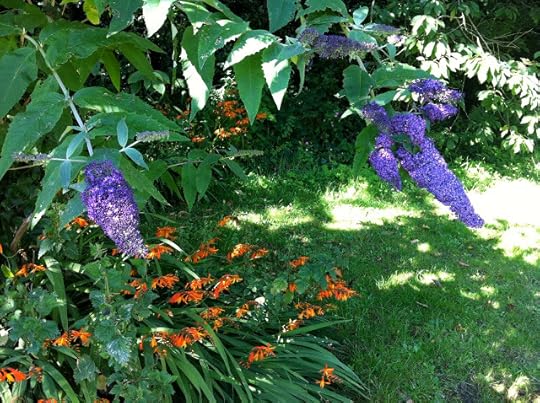 the gardens
the gardens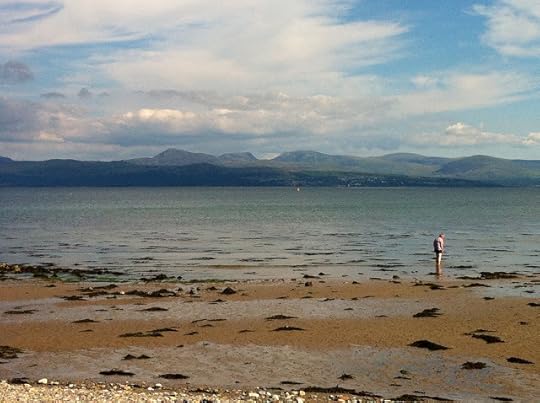 Penny contemplating the sea
Penny contemplating the sea  Daljit Nagra with me and some of the group in Criccieth Ice Cream Parlour
Daljit Nagra with me and some of the group in Criccieth Ice Cream Parlour Criccieth Castle
Criccieth Castle Criccieth flowerboxes
Criccieth flowerboxes
Published on September 25, 2012 00:22
July 16, 2012
Poetry from Art at Tate Modern: Edvard Munch
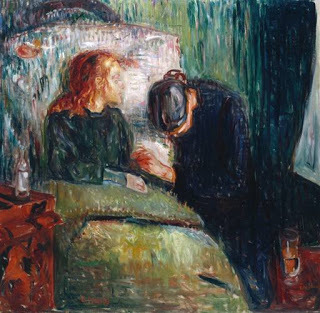
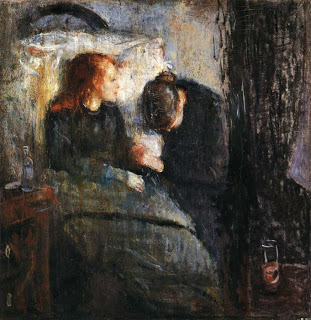
One of the main themes of the Edvard Munch exhibition at Tate Modern is how Munch not only reworked paintings over years but also painted multiple versions of the same subject over decades. For our last session of my Poetry from Art course we sat in the centre of the large deep red 'Reworkings' room, in between two facing versions of Girls on the Bridge, The Kiss, Vampire, Two Human Beings: The Lonely Ones, Ashes and The Sick Child. It was like inhabiting a slightly warped mirror.
We read the tightly formal poem 'Girls on the Bridge' by Derek Mahon, where each stanza is a diamond of mirroring rhymes and syllables, and the very moving 'The Sick Child' by Adam Thorpe, which is in two alternative parts, responding to the multiple version idea. Munch's sister Sophie died of TB when he was thirteen and the first painting in The Sick Child series was his breakthrough into his signature style, away from impressionism. He worked at the painting until the composition and colours expressed the force of the memory.
Munch has written about his process in his journals, here he is writing about colour as joy:
I made an observation as I walked along the street one sunny day on Karl Johan and saw the white houses against the spring blue sky – rows of people which in a give-and-take crossing stream like a ribbon drew themselves along the walls of the buildings. At that moment music reached in – playing a march – I saw the colors immediately change – it quivered in the air – it thrilled in the yellow white façade – the color dances in the stream of people – in the brightened and white parasols – yellow, light blue spring costumes – against the deep blue winter wraps which flickered in the gold trumpets, which beamed in the sun – it thrilled in blue and yellow. I saw differently under the influence of the music. The music doled out the colors. – I got a feeling of joy.And this is what he wrote about the genesis of The Scream:
One evening I was walking out on a hilly path near Kristiania – with two comrades. It was a time when life had ripped my soul open. The sun was going down – had dipped in flames below the horizon. It was like a flaming sword of blood slicing through the concave of heaven. The sky was like blood – sliced with strips of fire – the hills turned deep blue the fjord – cut in cold blue, yellow, and red colors – The exploding bloody red – on the path and hand railing – my friends turned glaring yellow white – I felt a great scream – and I heard, yes, a great scream – the colors in nature – broke the lines of nature – the lines and colors vibrated with motion – these oscillations of life brought not only my eye into oscillations, it brought also my ears into oscillations – so I actually heard a scream – I painted the picture Scream then.
We were surrounded by powerful emotions: grief, anguish, lust, greed, hope, loneliness. The task was to select a painting and its double and decide on the main emotion they contained, then write a poem about it, avoiding all abstract nouns such as 'joy' and 'grief'. It's a standard exercise in visualising emotions, to give them a colour, a smell, a taste, a sound, a texture, and I also asked if their emotion had a place: where did it happen? Finally, to include an animal: what animal was it? If they felt particularly ambitious they could use the form of their poem to address the double-painting aspect as Thorpe has. They could also rein in their emotions by using a formal straitjacket as Mahon has with his necklace of diamond-stanzas.
I was expecting anguish but was amazed when they all read back by how many people chose The Kiss and Vampire to respond to – it was a romantic end to our course! The next course will be from 15th October to 19th November this autumn, but I've yet to dream that up.
Published on July 16, 2012 08:03
July 6, 2012
A Poem for Frida Kahlo's Birthday, 6 July 2012

The Wounded Deer or The Little Deer is my favourite painting by Frida Kahlo. She painted it for her surgeon, after he operated on her spine, but the surgery failed. It's a portrait of her pet fawn Granizo ('Hailstones') but she has given him her face. There is so much that fascinates me about this portrait: the Catholic reference to St Sebastian, the fact that she is a male stag with antlers, and the symbolism of the numbers nine and ten (nine arrows, nine tines, ten trees, ten branches). But when I saw it at Tate Modern to read the following poem in front of it, what struck me was how small and faint the painting is, as if it's about to disappear.
The Wounded Deer
I have a woman's face
but I'm a little stag,
because I had the balls
to come this far into the forest,
to where the trees are broken.
The nine points of my antlers
have battled
with the nine arrows in my hide.
I can hear the bone-saw
in the ocean on the horizon.
I emerged from the waters
of the Hospital for Special Surgery.
It had deep blue under-rooms.
And once, when I opened my eyes
too quickly after the graft,
I could see right through
all the glass ceilings,
up to where lightning forked
across the New York sky
like the antlers of sky-deer,
rain arrowing the herd.
Small and dainty as I am
I escaped into this canvas,
where I look back at you
in your steel corset, painting
the last splash on my hoof.
From What the Water Gave Me: Poems after Frida Kahlo
available from Seren in the UK and Black Lawrence Press in the US. Also available from Amazon UK and Amazon US.
Published on July 06, 2012 03:29
July 3, 2012
Poetry from Art at Tate Modern: Touch Tour in Poetry and Dream 2012
On our fourth session of my Image-Making: Shaping Poems course at Tate Modern we were given a Touch Tour by Marcus Dickey Horley, who usually only does this for partially sighted or blind visitors. We got to touch the three sculptures available for this tour at Tate Modern: Alberto Giacometti's Walking Woman, Henri Laurens' Autumn and David Smith's Home of the Welder, or 'the man's doll's house' as we nicknamed it.

Four of us at a time could touch the bronze Autumn by Henri Laurens. Touching can only be done through lint free gloves but it's amazing how much you can feel through them. To write about the experience I handed out my Mental Imagery list of eight senses: sight, touch, hearing, taste, smell, the organic or inner body sense, kinesthesia and synesthesia. I also brought Keats' 'Ode to Autumn'.
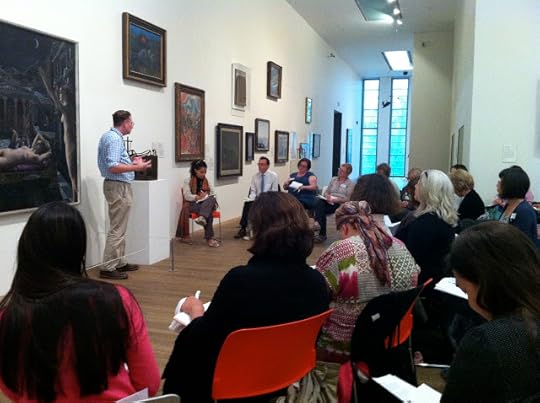
Here is Marcus introducing us to David Smith's Home of the Welder, behind him, so fragile (like a man's doll's house) that only one of us at a time could feel it.

Karen McCarthy Woolf touching Home of the Welder which is welded together.


Only two of us at a time could touch Giacometti's bronze Walking Woman, she is so thin! At one point Giacometti had given her arms and a head; one arm ended in feathers and the other in flowers, and her head was a cello. This was while she was still made of plaster. The final cast form is classic and archaic, and we discussed Tishani Doshi's poem 'Ode to the Walking Woman' where she becomes various ancient earth and sky goddesses, including Astarte, Cybele, and figures from a 3000BC archaelogical site in Pakistan, who are invited to "Sit / you must be tired" and "resurrect yourself, /make love to the sky, / reclaim the world."

Autumn by Henri Laurens (Bronze, 1948)
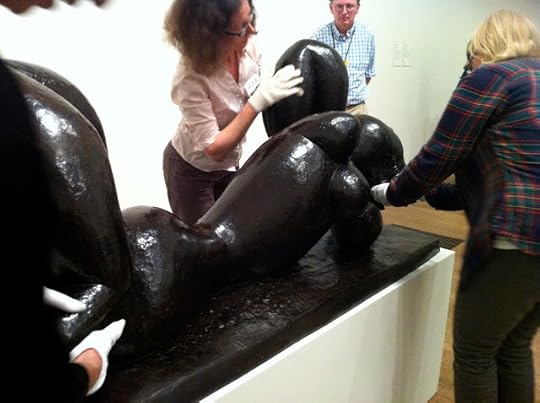
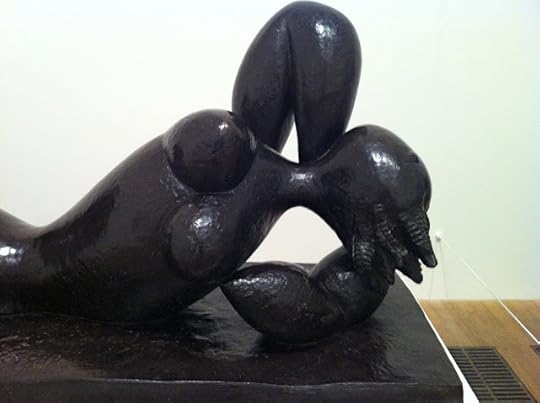


Four of us at a time could touch the bronze Autumn by Henri Laurens. Touching can only be done through lint free gloves but it's amazing how much you can feel through them. To write about the experience I handed out my Mental Imagery list of eight senses: sight, touch, hearing, taste, smell, the organic or inner body sense, kinesthesia and synesthesia. I also brought Keats' 'Ode to Autumn'.

Here is Marcus introducing us to David Smith's Home of the Welder, behind him, so fragile (like a man's doll's house) that only one of us at a time could feel it.

Karen McCarthy Woolf touching Home of the Welder which is welded together.


Only two of us at a time could touch Giacometti's bronze Walking Woman, she is so thin! At one point Giacometti had given her arms and a head; one arm ended in feathers and the other in flowers, and her head was a cello. This was while she was still made of plaster. The final cast form is classic and archaic, and we discussed Tishani Doshi's poem 'Ode to the Walking Woman' where she becomes various ancient earth and sky goddesses, including Astarte, Cybele, and figures from a 3000BC archaelogical site in Pakistan, who are invited to "Sit / you must be tired" and "resurrect yourself, /make love to the sky, / reclaim the world."

Autumn by Henri Laurens (Bronze, 1948)


Published on July 03, 2012 11:22
June 26, 2012
Poetry from Art at Tate Modern: Ewa Partum's Active Poetry
 Choosing 10 words from the circle, photo by participant Anne Welsh
Choosing 10 words from the circle, photo by participant Anne WelshChance plays a large part in Polish artist Ewa Partum's situational poetry installations. Her video installation at Tate Modern, Active Poetry , is from the '70s, and was groundbreaking then. She scattered letters from Joyce's Ulysses and other seminal works in landscapes such as seashores and woods, and let the elements rearrange them into poems of a new random language. She was also a feminist and appeared naked in her own performances as a protest "until women are equal in art".
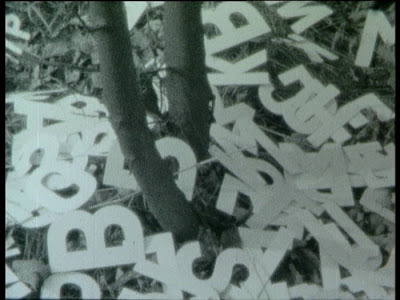 Active Poetry still from video by Ewa Partum
Active Poetry still from video by Ewa PartumFor the third session of my Image-Making: Shaping Poems course, we watched the grainy video of her scattering large letters to the wind, the floor in front of the video also covered with white letters. We each contributed ten favourite words to our own 'active poetry' pool and brought in our surreal definitions from the previous week in the Hirst exhibition, and displayed those separately. These included the lines:
"fire is an elixir giving immortality"
"a cigarette is something that stops your head exploding"
"a bone-saw is a prayer suspended in glass"
"scissors are sweet and heal wounds"
"an insect-o-cutor is sheer bliss"
"a skull is your enemy"
"an eye is a device to electrocute insects"
"a wing is a hypochondriac's larder"
"honey is a total eclipse of the sun"
We discussed 'collage' or 'mosaic' poems, where disparate phrases and images are clustered together in a non-linear way, but somehow have an underlying cohesive whole. I read out Yang Lian's poem 'The Winter Garden 1' from the anthology Jade Ladder: Contemporary Chinese Poets , which appears to be a collage of surreal images and contains lines like "the hurried night always wears brand new soles" and "the vole is an exhausted nurse stealthily/slinking into the garden's wounds". Another fantastic example of a 'collage' poem is by Karen McCarthy Woolf who is in our group, 'The Weather in the Womb' (from Ten: New Poets from Spread the Word ).
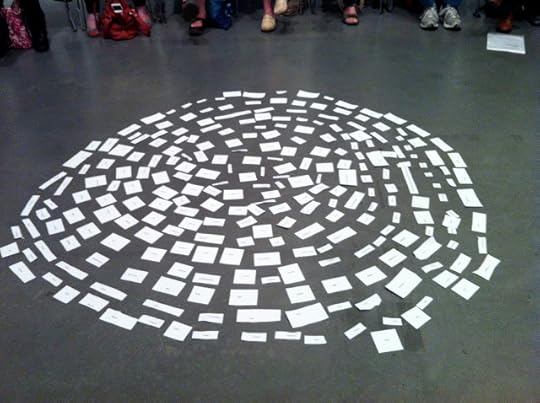
Everyone had to pick 10 words out of the circle, avoiding their own, and use one surreal definitions line as a lynch pin. They arranged their selections on the floor until the configuration started a short poem. They could of course insert other words to make grammatical sense, and add anything that came to mind. It was fascinating to see which words people had brought in, and how much they wanted to avoid their own, perhaps overused, 'pet' words. Also interesting to see who rushed to have the widest choice and who waited until the pool had shrunk. I suggested they close their eyes and just grab them.
 Anne Welsh's photo of her 10 words and surreal definition on the floor
Anne Welsh's photo of her 10 words and surreal definition on the floorAfter ten minutes of writing everyone read back their poems. It's a large group (twenty-three last night), and they have become adept at doing this fast and loud, against the gallery's bad accoustics.
They only had twenty minutes left of the one-and-a-half-hour session to form into small groups for friendly feedback on a poem they'd brought in from the term. Homework was to cut out a line from tonight's poem and place it in an environment – a garden, a wall, a shop, an office etc – and to return to it a few days later to see what happened to it and if that might add to the poem.
Published on June 26, 2012 12:10
June 20, 2012
Poetry from Art at Tate Modern: Damien Hirst's Anatomy of an Angel

"Every angel is terrifying", Rilke wrote, when he started his Duino Elegies. Damien Hirst's angel is no exception, being a hybrid of a kitsch snow-white Carrara marble beauty and an anatomy-lesson mannequin where the skin is cut away to reveal the internal organs and the skull. We set up our chairs around her for the second week of my Poetry from Art course in the Damien Hirst exhibition.
But before attempting 'angel' poems we went on a lightning tour of a few key exhibits in the show, just us and the full glory of Mother and Child Divided (where I pointed out the furry snout of the calf foetus inside the dissected cow), and the shark in its tank of turquoise formaldehyde. I steered the group away from the rotting cow's head and insect-o-cutored flies vitrine, since it wasn't looking its prettiest, past the pongy giant ashtray titled Crematorium, back to the end of the galleries, to the room adjacent to the angel. In many ways this room, containing both Black Sun and Black Sheep, is the antithesis of the angel-and-butterfly-mosaics display. Black Sun is a large circular black 'painting' made entirely of stuccoed flies in resin. I think it's one of Hirst's most inventive and evocative pieces, with its references to Beelzebub and black holes or anti-matter.
We read Selima Hill's poem 'See the Flies' and 'Sheep', both full of black humour, to see ways of writing responses that could be short, intense, oblique, personal, or funny. Our last vitrine was The Incomplete Truth, a perfectly preserved dove flying in formaldehyde, seedpearls or air-bubbles glistening around its claws.
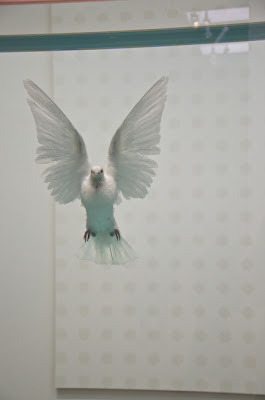
Here, I read out the Spanish/Argentinian poet Rafael Alberti's poem 'Dove', where everything is as reversed as Hirst's harbinger in its poisonous element, and the dove "to travel north she flew south.../ Believing the sea was sky, / That the night was dawn."
Back in the angel room we discussed Rafael Alberti's poems 'The Angel of Numbers' and 'The Good Angel', and recited the list of inspiring poem titles in his collection Sobre los Angeles (Concerning the Angels). Everyone particularly loved 'The Angel of Numbers' for its unexpected juxtaposition of maths with angels. We also read Selima Hill's funny 'Portrait of My Lover as an Angel' and the darker 'Love is Like a Terrifying Angel' from her fabulous collection Gloria: Selected Poems . This brought us back to Rilke, so I read out the first two stanzas of 'The Second Elegy' from The Duino Elegies to get us into writing mode.
They had just twenty minutes to write an angel, fly, dove or a cow poem, perhaps borrowing an approach from one of our examples. Our sessions only last one and a half hours so it's a bit of squeeze but we not only managed to hear everyone read back their excellent poems but also played a quick Hirstian instant surrealism game to close, a variation on the Surrealist Definitions game. I had collected 26 nouns (such as 'insect-o-cutor', 'pharmacy', 'fly') from the exhibition and printed each one on a strip of paper. These were folded up in a chocolate box, and selected at random. We had to briefly define our noun then tear the definition away from it and hand the definition to the person on the left so they had a different definition for their original noun. It worked wonderfully, and I've asked everyone to bring in their surreal definitions in next week, to use in the Ewa Partum video session, when we will be working with lots of word scraps on paper as she does.
At the end of each session we go upstairs to the Members' Bar for free drinks, and as it was a balmy evening we sat out on the terrace overlooking the Millennium Bridge and St Paul's, listening to the terrifying screeches of two peregrine falcons on the Tate Modern roof.
Published on June 20, 2012 10:26
June 12, 2012
Poetry from Art at Tate Modern: Damien Hirst's In and Out of Love
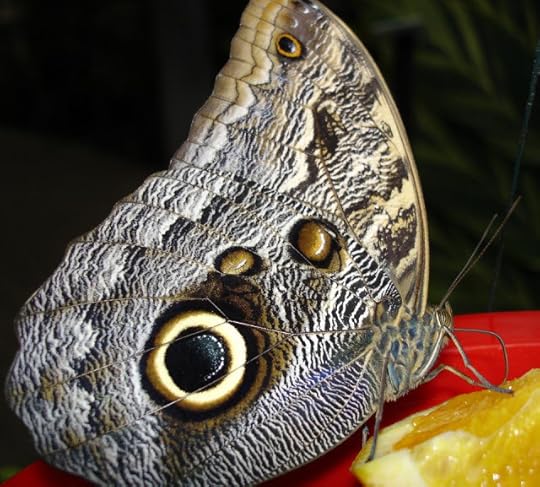
Last night was a memorable start to my summer course of Poetry from Art, in Damien Hirst's butterfly room In and Out of Love. The team at Tate Modern went to enormous lengths so that we could be there, as there was high maintenance going on in the rest of the show, including in A Thousand Years, the cow's head and hatching flies vitrine. We shouldn't really have been there but negotations went on (and on) and finally it was decided that we could enter our rooms, Pharmacy, as well as the butterflies, through a 'blue' back route, so the group got to see some secret corridors. We were then escorted directly into the butterfly room, which was so mesmerising that I had to coax everyone to come out the other side to our circle of chairs in Pharmacy.
Twenty-four of us sat assimilating the sensation of having giant tropical butterflies settling on us and tickling our arms. One owl butterfly escaped into Pharmacy with us but luckily he decided to land on me so I walked him back 'home' carefully through the translucent curtain strips. We divided the group into two halves, so half went straight back in, with notebooks and pens, to free-write, while group B stayed for discussion, then we swapped over.
We talked about Hirst's installation, and discussed three butterfly/moth poems: 'Monarchs' by Sharon Olds, and 'In the Pharmacy' and 'Tapestry Moths' by Peter Redgrove. All three poems combine the image of a moth or butterfly with something unexpected. This course is titled Shaping Poems: Image-Making, so we explored the idea of shaping a poem with two images clashed together. Olds' poem merges the Monarch butterfly with a first sexual encounter and a man with hands "like butcher's hands". Redgrove literally has his moths on a tapestry, so that they fly off, taking details of the scene away on their wings, laying parts of the pictures they've eaten into their eggs. Fragments of the tapestry pictures even end up in bats who eat the moths. In 'In the Pharmacy', a moth "like a travelling label walks/ From bottle to marble bottle with floury wings/ Embracing each and tapping with fernleaf tongue" on pharmaceutical bottles in a chemist's and we thought there was a juxtaposition between the chemistry of medicines and the metamorphosis inside a chrysalis. This was particularly apt because we were surrounded by a wall to wall pharmacy.
I think it's hard to write about butterflies. I remember being told that they were a subject to avoid in poems. But butterflies have supersenses. Morphos (which I've seen flying in the wild in the Venezuelan Amazon), have ears at the base of their metallic blue wings. When they flap lazily in the tropical sunlight they look like lightning flashes, and it's thought that this may be a form of defence, since one of their predators is baby jaguars, who catch them in play, much as my cats catch butterflies for snacks. They flash their iridescent wings to dazzle their prey. Butterflies taste with their feet, and maybe when they were settling on us it was to taste their evening visitors. Some pupae squeak when disturbed, so there could be a world of butterfly language yet to be discovered. They see more colours than we do too.
Our session was shorter than usual because of the winding back route to the rooms so the group had even less time to write, only 10 minutes after the note-taking in situ, but already some butterfly poems are pupating. Next week we will be in another part of the Hirst exhibition. I ask that they come with fresh eyes, try to disregard the hype and criticism about this artist. The show is full of invention. For me, it's a dream, stuffed as it is with curiosities of natural history and echoes of Catholic iconography, which must come from Hirst's childhood Catholicism.
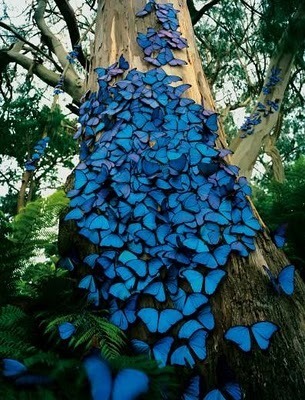
Published on June 12, 2012 04:06



